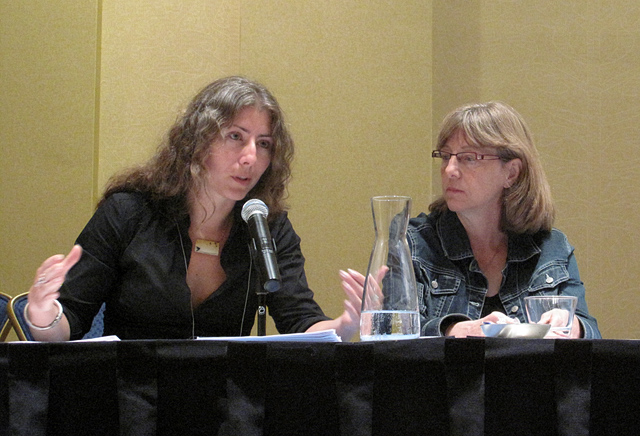Covering Invisible Populations

"Why am I doing this? Because I think it's incredibly important for you and for the audience to hear this story." Documentary photographer Mimi Chakarova said this of the risks and challenges entailed by her latest project on Iraqi rape victims. But the same could have been said by either of her fellow panelists as they talked about "Covering Invisible Populations" at the Investigative Reporters and Editors conference on Saturday.
The work they discussed during the panel, sponsored by the Dart Center and the Dart Society, was superficially diverse: Omaha World-Herald reporter Karyn Spencer's award-winning series on Nebraska's bungled coroner system; stories by Ruth Teichroeb (above, right) on federal prisoners and the developmentally disabled; Chakarova's photography of women sold into sex trafficking. But their diverse subject matter belies striking similarities in the challenges they posed for reporting and storytelling.
Interviewing the Invisible
As Teichroeb pointed out, "When you're trying to do a story about the disenfranchised, people who are on the fringes of society, they're not going to be easy to find." Once found, they may require a significant investment of time to develop trust, comfort and the understanding necessary to make an informed decision to tell their story. This is particularly true for those radically disempowered by violence. For Chakarova's sensitive work on sex trafficking, she said, "It takes three or four years to get a woman to go on camera to tell her story ... [It] involves an incredible amount of trust." Teichroeb suggested journalists assume that everything will take much longer than a typical interview, so they can explain what terms like "on the record" mean, how going on the record could affect their lives and to otherwise allow their disempowered sources a measure of control over their own story.
Keeping Safe
Not only do reporters need to mind their subjects' safety; they must mind their own. Staying safe, according to Chakarova, is "maybe 35% common sense, maybe 15 to 20% experience and the rest is luck. The rest is definitely luck." From common sense and experience, she advocated training for strength, self-defense and running ability. Always look around the room and make sure you have an exit strategy before you begin an interview, and never show fear.
For her part, Spencer does routine background checks. If she thinks she may be going into a dangerous situation, she leaves information, such as where and for how long she is going, with someone she knows "has [her] back."
Telling the Story
Making an individual story not only visible but meaningful requires providing a wider context and scale that readers can understand. Teichroeb tries to find "that database of information that says it isn't just this person who's been molested alone or been locked up ... but that this has been going on for decades." Then she reports on possible solutions to the wider problem.
Conversely, Karyn Spencer tries to maintain readers' interest in the "policy story" by interweaving narrative into or alongside it. Sometimes, an appalling detail does the trick; for instance, a coroner's reason why health statistics might be skewed: "Well," he said, "If I don't know [why someone died], I put down heart attack."
When dealing with traumatic events, effective storytelling can also mean omitting details that arouse shock instead of understanding. Chakarova described declining women who asked her to photograph the cigarette burns on their chests. She decided this wouldn't further her goal: "to get the viewers to pay attention to the story and not feel ... pity."
In details of method, there were differences between panelists as there will always be between journalists. But, ultimately, as Chakarova said:
"Each one of us has to be able to live with what you do. And most importantly be able to close your eyes at night and get a good night's rest and not have these images and these ghosts haunting you."